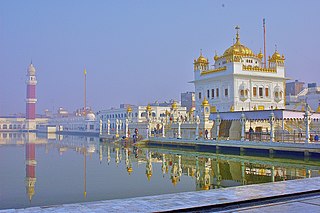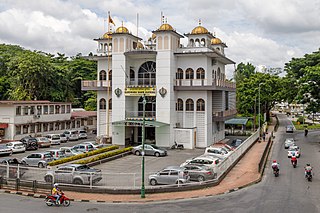
A gurdwara or gurudwara is a place of assembly and worship for Sikhs but its normal meaning is place of guru or "Home of guru". Sikhs also refer to gurdwaras as Gurdwara Sahib. People from all faiths and religions are welcomed in gurdwaras. Each gurdwara has a Darbar Sahib where the Guru Granth Sahib is placed on a takht in a prominent central position. Any congregant may recite, sing, and explain the verses from the Guru Granth Sahib, in the presence of the rest of the congregation.

Klang or Kelang, officially Royal City of Klang, is a city, royal city and former capital of the state of Selangor, Malaysia. It is located within the Klang District. It was the civil capital of Selangor in an earlier era prior to the emergence of Kuala Lumpur and the current capital, Shah Alam. Port Klang, which is located in the Klang District, is the 12th busiest transshipment port and the 12th busiest container port in the world.

Gurdwara Sri Tarn Taran Sahib, officially Gurdwara Sri Darbar Sahib, is a gurdwara established by the fifth guru, Guru Arjan Dev, in the city of Tarn Taran Sahib, Punjab, India. The site has the distinction of having the largest sarovar of all the gurdwaras. It is famous for the monthly gathering of pilgrims on the day of Amavas. It is near Harmandir Sahib, Amritsar.

Anandpur Sahib, also referred simply as Anandpur, is a city in Rupnagar district (Ropar), on the edge of Shivalik Hills, in the Indian state of Punjab. Located near the Sutlej River, the city is one of the most sacred religious places in Sikhism, being the place where the last two Sikh Gurus, Guru Tegh Bahadur and Guru Gobind Singh, lived. It is also the place where Guru Gobind Singh founded the Khalsa Panth in 1699. The city is home to Takhat Sri Kesgarh Sahib, the third of the five Takhts in Sikhism.

The Takht Sri Darbar Sahib Damdama Sahib, is one of the five takhts or Seat of Temporal Authority of Sikhism, located in Talwandi Sabo, near the city of Bathinda in Bathinda district of Punjab, India. At this place Guru Gobind Singh, the tenth Sikh Guru, prepared the full version of the Sikh scriptures called Sri Guru Granth Sahib in 1705. The other four Takhts are the Akal Takht, Takht Sri Keshgarh Sahib, Takht Sri Patna Sahib and Takht Sri Hazur Sahib.

Rawang is a town and a mukim in Gombak District, Selangor, Malaysia, about 23 km northwest of city centre Kuala Lumpur.
Federal Route 5 is one of the three north–south oriented backbone federal roads running along the west coast of Peninsular Malaysia, Malaysia. The 655.85 kilometres (408 mi) federal highway runs from Jelapang, Perak in the north to Skudai, Johor in the south.

A Granthi is a person, female or male, of the Sikh religion who is a ceremonial reader of the Guru Granth Sahib, which is the holy book in Sikhism, often read to worshipers at Sikh temples called a Gurdwara.

Setia Alam is a township located in Shah Alam, Selangor, Malaysia. It is accessible via Setia Alam Highway from the New Klang Valley Expressway (NKVE) since the interchange was opened on 14 July 2006. Setia Alam is also accessible from the Federal Highway and Klang via Jalan Meru. This township is developed by S P Setia Berhad.

Italian Sikhs are a growing religious minority in Italy, which has the second biggest Sikh population in Europe after the United Kingdom (525,000) and sixth largest number of Sikhs in the world. It is estimated that there are 220,000 Sikhs in Italy, constituting 0.3% of the total Italian population.

Dutch Sikhs form a religious minority in the Netherlands. They number around 15,000 and most of them live in or around Amsterdam. There are nine gurudwaras in the Netherlands.

Malaysian Sikhs are known to be the fourth largest Malaysian Indian ethnic group. It is estimated that there are around 100,000 Sikhs in Malaysia.
The Methodist Girls' School, Klang is a semi-government-aided, all-girls' school—consisting of a primary and secondary school—located on Jalan Raya Barat in the Klang District of Selangor state, in Malaysia. The school was established by Ruth Eklund on 24 May 1924, after she discovered that there were a number of female pupils attending the Anglo Chinese School during the academic year.

Sikhism in Bangladesh has an extensive heritage and history, although Sikhs had always been a minority community in Bengal. Their founder, Guru Nanak visited a number of places in Bengal in the early sixteenth century where he introduced Sikhism to locals and founded numerous establishments. In its early history, the Sikh gurus despatched their followers to propagate Sikh teachings in Bengal and issued hukamnamas to that region. Guru Tegh Bahadur lived in Bengal for two years, and his successor Guru Gobind Singh also visited the region. Sikhism in Bengal continued to exist during the colonial period as Sikhs found employment in the region, but it declined after the partition in 1947. Among the eighteen historical gurdwaras in Bangladesh, only five are extant. The Gurdwara Nanak Shahi of Dhaka is the principal and largest gurdwara in the country. The Sikh population in the country almost entirely consists of businessmen and government officials from the neighbouring Republic of India.

Sikhism in Japan is a small, minority religion. There are gurdwaras located in Tokyo, Ibaraki and Kobe.
The following is an alphabetical list of articles related to Selangor.

Pasar Jawa LRT station is an elevated light rapid transit (LRT) station and serves as one of the stations for the Shah Alam line. The station is located in the city of Klang, Selangor one of the world's major international port cities and as global transhipment hub of Malaysia. The station is surrounded by most of the major landmarks in the areas are business and commercial districts of Klang North as compared to South Klang which is mostly government departments. This station mainly serves urban localities that use Lebuhraya Persekutuan, Jalan Meru, Jalan Kapar and Jalan Langat which are the four major roads servicing the area.

The Guru Nanak Darbar is a Sikh gurdwara at Jebel Ali Village in Dubai, founded in 2012 to serve over 50,000 Sikh residents in the emirate. The community-run gurdwara is the first official Sikh gurudwara in the GCC region and the Middle East, and it was established by Surender Singh Kandhari, a resident of Dubai since 1976.















